The Jose Fernandez boating tragedy, some safety thoughts
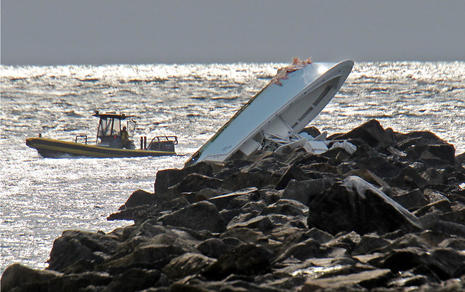 You probably already know at least the rudiments of the story. At about 3 am on Sunday, three young men died when their 32-foot center console fishing boat engaged at high speed with the long north jetty that guards the Port of Miami's Government Cut channel. Just the violence of the crash -- it was heard by a policeman on shore nearly a half mile away -- was noteworthy, but the owner and probable driver was the beloved budding baseball star Jose Fernandez. It's a deeply tragic story as is, but is there anything in it to learn about boating safety?
You probably already know at least the rudiments of the story. At about 3 am on Sunday, three young men died when their 32-foot center console fishing boat engaged at high speed with the long north jetty that guards the Port of Miami's Government Cut channel. Just the violence of the crash -- it was heard by a policeman on shore nearly a half mile away -- was noteworthy, but the owner and probable driver was the beloved budding baseball star Jose Fernandez. It's a deeply tragic story as is, but is there anything in it to learn about boating safety?
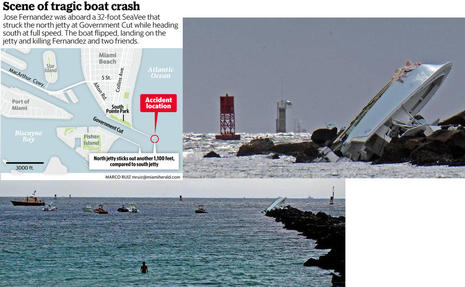 The Miami Herald has provided excellent coverage and photography of the accident, and many boaters from all over the world are already familiar with the spot because Miami is such a busy transient port and also the home of two major winter boat shows. The jetties are nasty, particularly the longer, lower northern one, but I question the necessity of putting end-to-end fixed lights on them as this local boater calls for. Numerous aids to navigation already define the safe channel well and a great many boaters successfully clear the jetties every day and night.
The Miami Herald has provided excellent coverage and photography of the accident, and many boaters from all over the world are already familiar with the spot because Miami is such a busy transient port and also the home of two major winter boat shows. The jetties are nasty, particularly the longer, lower northern one, but I question the necessity of putting end-to-end fixed lights on them as this local boater calls for. Numerous aids to navigation already define the safe channel well and a great many boaters successfully clear the jetties every day and night.
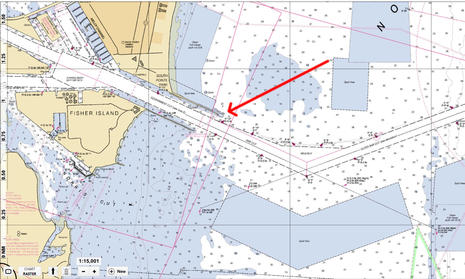 I've gone in and out of Miami countless times, and in recent years it's usually been center console electronics demos on which it was legal, time efficient, relatively safe, and usually fun on a fast plane. In fact, when Garmin took us kite fishing last April, we cut left out of the channel just past the north breakwater to run up to the nearshore sailfish spot, and that seems to be a common route. But the seasoned charter fishing captain did not make that turn until we were also past the big R "12" lit buoy, as you can see fairly well in this Virb XE video of that trip, which also shows a bigger powerboat inbound on the same route at speed. In other words, the Fernandez boat only missed a common path back into Miami by about 100 yards.
I've gone in and out of Miami countless times, and in recent years it's usually been center console electronics demos on which it was legal, time efficient, relatively safe, and usually fun on a fast plane. In fact, when Garmin took us kite fishing last April, we cut left out of the channel just past the north breakwater to run up to the nearshore sailfish spot, and that seems to be a common route. But the seasoned charter fishing captain did not make that turn until we were also past the big R "12" lit buoy, as you can see fairly well in this Virb XE video of that trip, which also shows a bigger powerboat inbound on the same route at speed. In other words, the Fernandez boat only missed a common path back into Miami by about 100 yards.
Nor is it unusual to be out there at 3 am. I have numerous friends in the boating industry who regularly sacrifice a good night's sleep after a long day's work at the Miami International or Yachts Miami Beach shows to enjoy fishing in the balmy dark, and I'm sure it can be quite exhilarating. Even in the daytime, the variety of game fish and the warm, quiet solitude available right off the bustling city are memorable. So what went so terribly wrong on board Kaught Looking?
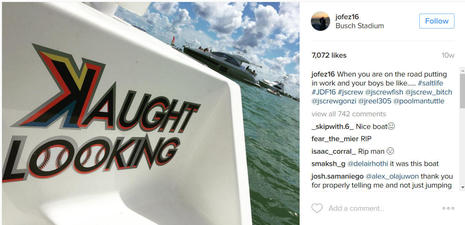 While it's quite possible that we'll never know exactly what happened, the age of social media means that we can get some sense of Jose Fernandez as a boater. Posting on Instagram as jofez16, and often tagged with his J's Crew fishing buddies (their sailfish video here), Fernandez seemed as enthustiastic about angling as he was about baseball, and he'd obviously spent some serious time on fast center consoles like the one he eventually purchased for himself.
While it's quite possible that we'll never know exactly what happened, the age of social media means that we can get some sense of Jose Fernandez as a boater. Posting on Instagram as jofez16, and often tagged with his J's Crew fishing buddies (their sailfish video here), Fernandez seemed as enthustiastic about angling as he was about baseball, and he'd obviously spent some serious time on fast center consoles like the one he eventually purchased for himself.
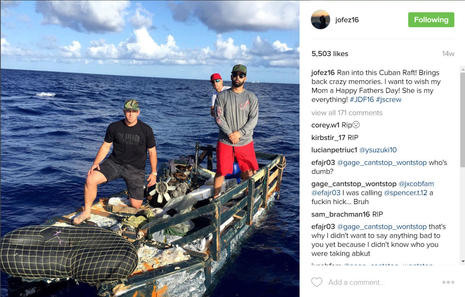 Fernandez had also famously defected from Cuba to Mexico by boat, saving his overboard mother along the way, at age 15 on his fourth attempt to reach the USA. He had to be aware of the sea's danger. But he was also just 24 years old and I'd guess naturally occurring testosterone as a contributing factor to the accident, which doesn't mix well with the alcohol now being cited as a possible influence (plus an argument with the girlfriend whose pregnancy Fernandez had just announced). Yesterday, in fact, we learned that his friends were quite concerned about his boat driving abilities that night, and the terrible crash is beginning to look like a pure case of bad operator judgment.
Fernandez had also famously defected from Cuba to Mexico by boat, saving his overboard mother along the way, at age 15 on his fourth attempt to reach the USA. He had to be aware of the sea's danger. But he was also just 24 years old and I'd guess naturally occurring testosterone as a contributing factor to the accident, which doesn't mix well with the alcohol now being cited as a possible influence (plus an argument with the girlfriend whose pregnancy Fernandez had just announced). Yesterday, in fact, we learned that his friends were quite concerned about his boat driving abilities that night, and the terrible crash is beginning to look like a pure case of bad operator judgment.
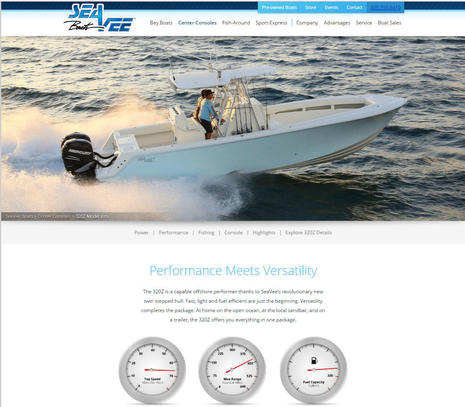 However, let's also consider the high performance boat that Fernandez was driving and also the high performance electronics that were probably installed. I don't fault either a bit -- in fact, I think they are pretty fantastic -- but you can also view them as enabling ingredients in the tragedy. When I first acquired the 25-foot IO Ralph after decades mostly on sailboats, one of my strongest (middle-aged) conclusions went something like this: "Geez, after learning to be so careful on complex boats that only topped out at about 8 knots, this is almost as easy to operate as a car and yet so much more dangerous at 25 knots."
However, let's also consider the high performance boat that Fernandez was driving and also the high performance electronics that were probably installed. I don't fault either a bit -- in fact, I think they are pretty fantastic -- but you can also view them as enabling ingredients in the tragedy. When I first acquired the 25-foot IO Ralph after decades mostly on sailboats, one of my strongest (middle-aged) conclusions went something like this: "Geez, after learning to be so careful on complex boats that only topped out at about 8 knots, this is almost as easy to operate as a car and yet so much more dangerous at 25 knots."
The SeaVee 32Z Fernandez owned is a particularly sporty design with a stepped hull able to reach speeds over 60 mph with twin outboards and still behave safely in the right hands (as well explained in this SeaVee video). And while I don't know what electronics were aboard Kaught Looking, every similar boat I've seen has had at least big screen chartplotting and radar that a focused, skillful driver could use to go fast in the dark with reasonable safety. In fact, I saw a very good example of this last week at the NMEA Conference in Naples, Florida.
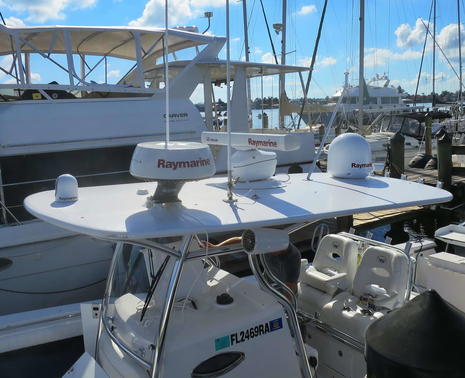 I originally took this photo to show how poorly Raymarine had temporarily installed the Quantum radar on this Southport 33 (because nonetheless neither radar showed interference from the other, similar to what my recent testing has shown). But take away the Quantum and you're looking at the gear an excellent young skipper often uses to run fast at night. He is Captain TJ of 2 Shea dive and fish charters, and I wouldn't hesitate to ride along. And mind you, at age 69 -- and with possibly lower testosterone levels -- I'm very aware of high speed boating dangers. I hang on carefully, I check out the driver studiously, and I don't hesitate to ask a possibly imperfect one to please slow the hell down.
I originally took this photo to show how poorly Raymarine had temporarily installed the Quantum radar on this Southport 33 (because nonetheless neither radar showed interference from the other, similar to what my recent testing has shown). But take away the Quantum and you're looking at the gear an excellent young skipper often uses to run fast at night. He is Captain TJ of 2 Shea dive and fish charters, and I wouldn't hesitate to ride along. And mind you, at age 69 -- and with possibly lower testosterone levels -- I'm very aware of high speed boating dangers. I hang on carefully, I check out the driver studiously, and I don't hesitate to ask a possibly imperfect one to please slow the hell down.
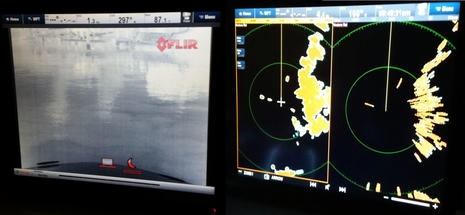 At any rate, it was quite telling to observe TJ with a somewhat rowdy boatload of NMEA folks negotiating dark, shallow, and congested Naples Bay sometimes on plane. Normally, I learned, he'd have the big righthand gS195 MFD split screened with radar and radar overlaid charting, but full screen directly in front of his driving position was the output of a Flir thermal camera, and he was quite adamant about how he uses it. It's the basic fixed T200 model and he's carefully adjusted its tilt angle -- done with a wrench while tied up -- so it best shows the crap pots that neither chart nor radar can help him with. He's tried the contrast and color palette options, but this is now how he uses the camera, period.
At any rate, it was quite telling to observe TJ with a somewhat rowdy boatload of NMEA folks negotiating dark, shallow, and congested Naples Bay sometimes on plane. Normally, I learned, he'd have the big righthand gS195 MFD split screened with radar and radar overlaid charting, but full screen directly in front of his driving position was the output of a Flir thermal camera, and he was quite adamant about how he uses it. It's the basic fixed T200 model and he's carefully adjusted its tilt angle -- done with a wrench while tied up -- so it best shows the crap pots that neither chart nor radar can help him with. He's tried the contrast and color palette options, but this is now how he uses the camera, period.
Perhaps most important was TJ's focus. At slow speeds he was fine with questions and small talk, charming actually, but when he demonstrated high speed operation, he went into a zone of high attention (and I felt comfortable). Good judgment, skills, proper tools, and realtime focus -- aren't these the core elements of safe boating?
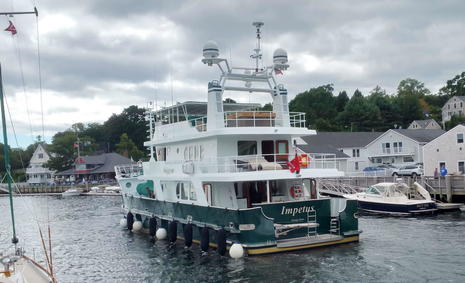 And you don't have to be going fast at night to make a significant mistake. Earlier this month, and not long after writing about a possibly tired sailboat crew going hard aground in my home harbor, I photographed this departing expedition yacht passing my Camden mooring float. It would have only been an addition to Marine Traffic's great photo archives if I hadn't been monitoring VHF 16 (and here's my chance to add a little levity to this entry).
And you don't have to be going fast at night to make a significant mistake. Earlier this month, and not long after writing about a possibly tired sailboat crew going hard aground in my home harbor, I photographed this departing expedition yacht passing my Camden mooring float. It would have only been an addition to Marine Traffic's great photo archives if I hadn't been monitoring VHF 16 (and here's my chance to add a little levity to this entry).
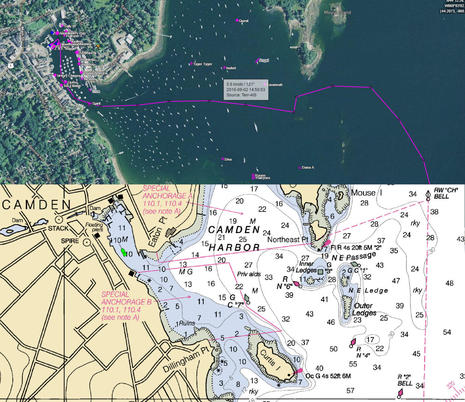 "Careful, cap, it's bony in there" is what I heard some anonymous local boater broadcast about 10 minutes after taking the photo of the 195 ton Impetus. And while that certainly made me wonder what was going on, I really had to know when a few minutes later the same voice came back on 16 with, "Guess you might want to change your undershorts now, eh cap?" The still anonymous wit who may have helped to avert a serious accident did get back to me on another channel and explained, as confirmed by the AIS track above, that Impetus had briefly tried to exit Camden between the R "6" nun and the G "3" beacon, just a few yards drastically wrong for NE Passage.
"Careful, cap, it's bony in there" is what I heard some anonymous local boater broadcast about 10 minutes after taking the photo of the 195 ton Impetus. And while that certainly made me wonder what was going on, I really had to know when a few minutes later the same voice came back on 16 with, "Guess you might want to change your undershorts now, eh cap?" The still anonymous wit who may have helped to avert a serious accident did get back to me on another channel and explained, as confirmed by the AIS track above, that Impetus had briefly tried to exit Camden between the R "6" nun and the G "3" beacon, just a few yards drastically wrong for NE Passage.
I have no idea what was going on inside that wheelhouse but I fear that a professional was involved and given that it was nearly high tide, that big boat might have been stuck on the "bony" Inner Ledges for a very long time. I'll also note that southbound boats normally leave via the wide southern channel anyway, and I, too, may be capable of such a major brain freeze in an unfamiliar navigation situation. Co-navigators are a good thing.
At any rate, had those 195 tons of steel vessel gone aground at about 6 knots, everyone aboard might have been unhurt or just banged up a bit. High speed boating, as exhilarating and even useful as it can be, adds an extra level of danger that we cannot be too aware of. While it may not pass parenting standards these days, I will never forget what my hard-boiled dad did to me when I was 16 and learning to drive. It wasn't hard for him to find the scene, as we lived near the going-home-drunk side of the Connecticut and New York border when the legal drinking age was 18 in NY and 21 at home. It was at a local garage on a quiet Sunday morning and the side of the car that had first hit a big oak tree at something like 90 mph was crushed in almost to the other side. There was broken glass, a bad odor, blood, even bits of flesh, and flies.
I was still a sometimes dangerous teenage male driver for a few years, just one with a deeply implanted grisly image that may have helped me finally realize some good sense (along with an accident or two). And I fear it took many more years before I could truly feel the tragedy of an exuberant young life suddenly and unneccessarily snuffed out. I've only gotten to know Jose Fernandez from afar, and too late, but his seems to be that story writ very large and especially contemporary in our world of celebrity sports and strained immigration. Miami and the Marlins honored him beautifully Monday night, when he should have been pitching against the Mets, and I too truly hope he rests in peace.


 Share
Share
Outstanding blog post. I commend you for this well written piece. This young man certainly deserves the positive reinforcement from his many communities such as ours in the boating world and also those from professional sports and the local Miami area.